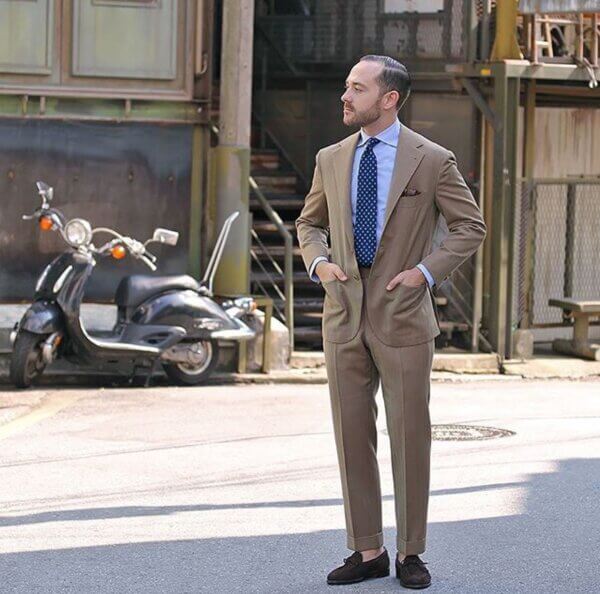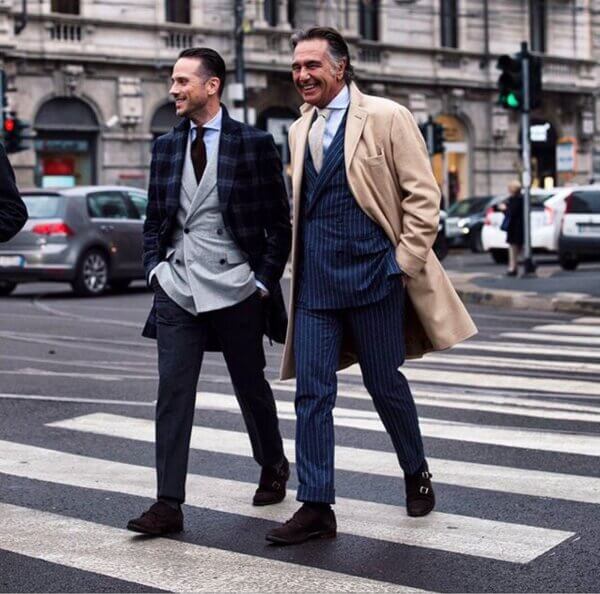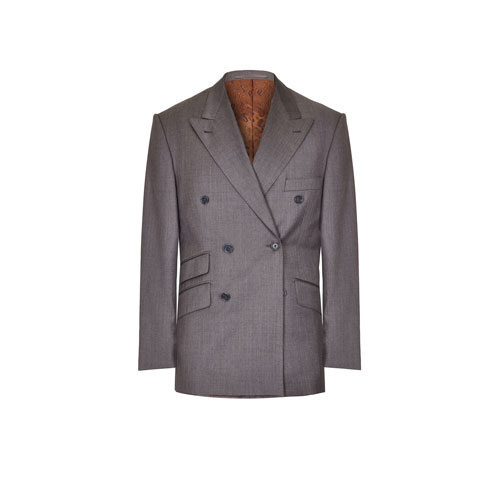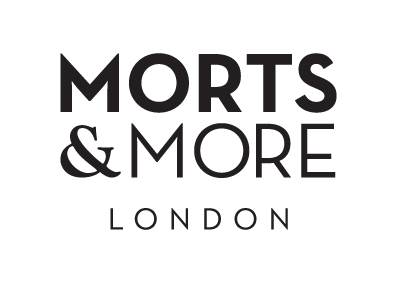Blog, Men's Styling Advice
5 Points You Need To Know To Help Your Cuffed Trouser Immediately
1. Why would you wear a cuffed trouser?
It’s safe to say that a cuffed trouser is thing of preference. They are not a requirement of any dress code commonly known, so wearing them is a personal style choice.
Cuffs will add weight to the bottom of your trousers and make pleats stand out. This comes together to help the fabric drape and hang better.
‘Visual’ balance is another advantage to wearing them – the size and cut of a double-breasted jacket can be balanced out by the extra fabric on the trouser cuff. A similar balancing effect can be seen with vertically striped suits.
Some believe that a pair of trousers with cuffs signify quality – this is debatable; however, it has been a popular option with bespoke suits for many years.
Another visual effect of a cuffed trouser is that they accentuate a man’s height. We’ll touch more upon this later in this post.
Regardless of cuffs being optional, they can definitely change the feel of an outfit.
2. What are cuffs?
A cuff (also known as a turn up) is simply excess fabric folded (outside the trouser leg) at the bottom hem of your trousers. The alternative to cuffs would be a hem – which is when the excess fabric is folded back up and inside the trouser leg. These are the only two types of finishes you’ll see on a trouser bottom. Hems are the most popular among men.
Cuffed trousers were often worn by schoolboys – with them growing rapidly in height, and outgrowing their trousers quickly. If you will let out the cuffs, you could lengthen pair of trousers easily.
The size of a cuff can range from under one inch to all the way up to three inches. The most common size we tend to see in everyday life is typically between one and a half inches or two inches.
Fun fact: You can add a faux cuff to a pair of finished trousers – it is cut separately and then sewn on.
Many believe that flat-front trousers should not have cuffs. The styles are too much of a mismatch. We’re not a big fan of hard and fast style rules, as its all individual expression. That’s not to say that we don’t have some strong opinions and preferences (such as never wearing brown shoes and black trousers). Well regardless of our opinions on rules, its still a good idea of what the rules are. Bending or breaking rules is one thing – ignorance is never acceptable.
So here are the rules pertaining to pleats and cuffs;
- Double pleated trousers should always have cuffs.
- Single pleated trousers can be worn with or without cuffs.
- Flat-front trousers should not be worn with cuffs.

3. Where would you wear cuffs?
Cuffs are certainly seen in and around the city, especially amongst the more power dressing professions. Cuffs are almost synonymous with a man working in finance (let’s call him a banker) who wears a pinstriped double-breasted suit. You could probably picture a lawyer in this outfit too.
In recent times cuffs can be seen casually placed on a pair of flat front chinos. Super casual! To be honest cuffed trousers are not a formal garment, regardless of power dressing city men wearing them. They have always been seen as less formal than hemmed trousers. They’ve yet to be seen with a dinner suit.
4. When would you wear cuffs?
You can find cuffs all year round, in all manner of fabrics such as seersucker, worsted wool, cotton, flannel, & tweed.
A cuffed trouser is not limited to any season or occasion. It’s also optional. So ultimately, it’s all about having a penchant for the style.

5. How should your cuffed trouser fit?
Typically, a trouser cuff is measured to just sit on your shoe with the trouser leg draping as straight as possible. Unlike the hemmed trouser which tends to have one full or half break when cut to correctly. As with the pictures we’ve added to this post, you’ll see that cuffed trousers tend to fall on the shorter side.
When a cuffed trouser is too long, it just pools around the shoes and looks untidy. It’s also counterintuitive to having the pleats, as the pleats will help to create a crease line, but the folds of fabric at the bottom with take it away. Be extra careful with this bunching effect especially when wearing boots, as your trouser leg will need to be slightly wider to go over the boot and rest at the ankle. Without that width it can get very messy looking.
Earlier we spoke briefly about cuffs accentuating a man’s height. Now we’ll delve a little deeper. Rule of thumb is that the taller a man is, the taller he can have his cuff as he so chooses – the shorter the man is, the shorter the cuff should be if any cuff at all. The reason for this is that cuff runs a horizontal line across the top of the ankle which gives a shortening effect. It plays on people’s perception of your height, as the seam line is reduced and the pant leg appears to end sooner than it does.
We’ve seen a rule that states if a man is 5’10” or under, then his cuffs should be 1 1/2” but if a man is taller than this then his cuffs should be 1 3/4”. You already know our opinion on rules. Do as you wish with this one.
Lastly, I mentioned this earlier and felt it worthy of being mentioned here again. Balance is key when it comes to cuffs. When designing your suit try to balance out the size of your trouser cuff with other aspects of your suit – such as lapel width. Having one wide and another slim can throw off the way your suit looks. It’s similar to when I say that your tie width should match your lapel width, and your tie knot should complement your shirt collar spread.
As always, like, comment and share our content if you enjoy it – we appreciate the support you give us always!
We’ll catch you on our next blog post!
Morts and More


